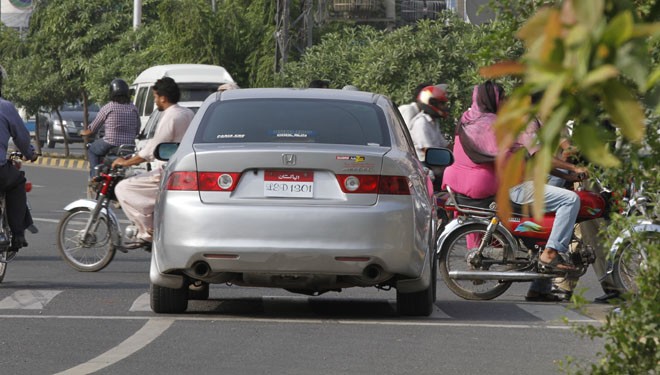

Muhammad Ali, an employee at a shop dealing in number plates, name plates and metal plaques, receives a large number of customers every day. Majority of these visitors are owners of newly bought vehicles who come here to buy the number plates. They prefer to get a replica of the computerised number plates issued by the Motor Vehicle Registration Authority (MVRA) which works under the Excise & Taxation Department, Punjab.
The department used to receive number plate issuance fees from all those who came to get their vehicles registered with the department. They were issued computerised number plates after some time but back in 2012 it stopped receiving the amount. There was a suspension in issuance of these number plates because of some disputes over the grant of contract to manufacture these number plates. The current situation is that the department has stopped receiving fees to issue new number plates and is concentrating on clearing the backlog, albeit slowly.
This was a breather for the private number plate manufacturers who were thinking about closing their shops, says Ali who has seen a sudden urge in the business. The Excise & Taxation department has given them an approval, though verbal, to manufacture the plates that look similar to the ones issued by them.
Though the shape looks the same it is different in a sense that it does not carry the same material and important data embedded into it.
Babar Ali, a customer who stands next to him, says that such concession is only for those vehicle owners who have not been issued a computerised number plate by the department. A person who has been issued one has to provide justification if he has placed a replica on his vehicle. For example, if he lost his number plate or it got broken he will have to produce a report he had filed in the police station.
Normally, such a person has a police report as it is required to get a duplicate number plate from the excise department.
While there was an attempt at standardising the procedures, enforcement has always remained an issue, says a traffic police officer who does not want to be named.
The officer further says that despite restrictions the people are using fancy number plates with numbers written in strange, illegible fonts. "Why can’t they be forced to use the standardised ones?" he asks. "Why nobody acts against the manufacturers of such fancy number plates?"
He reveals that anybody who has even a distant relative in a government post or knows someone influential thinks it is their right to violate rules. Placing fancy number plates is one such violation, he adds.
The official suggests that before computerising the record of automobiles, the government should have gone for standardisation of number plates which could be read by smart cameras. With the number of vehicles rising with the day, he says, their inspection will ultimately have to be done by smart cameras. Such cameras can match the numbers immediately with the data in the backend and send signals whether a particular vehicle is stolen or snatched.
According to Imran Aslam, Director, Excise & Taxation, Lahore, the department has started sending number plates to vehicle owners via courier service. The plates are being manufactured in Lahore but the raw material has to be imported from abroad.
"The department is trying its best to clear the backlog," he says. "The import of this material is regulated so it is not possible for private parties to import it without authentication and sell it in the local market."
At the moment, Imran says, the department is dispatching number plates of a series launched in 2013 to the owners of vehicles via courier. "For the time being we have stopped collecting fees for the issuance of computerised number plates with inbuilt security features."
Aslam explains how the concept of computerised number plates was introduced to help the law enforcement authorities detect fake number plates and recover the stolen vehicles. "There are certain hidden features of these plates which are only shared with the concerned officials," he says.
"The purpose of the entire exercise is to standardise the design of number plates." It was possible as the responsibility of issuance of these plates was given to one agency.
While the project of computerised number plates faces hiccups, the Excise & Taxation department is working on computerisation of records of all the vehicles registered in the province. This serves the purpose for which computerised number plates were launched, say sources in the department.
The said database contains computerised records of all the vehicles registered so far.
Anybody can send the registration number of a vehicle at 9966 via sms or enter it in the search box at website to retrieve comprehensive data about a particular vehicle, says Aslam. So, anybody who find a suspected vehicle can retrieve this information.
While the website data is not fully up-to-date, sources say the SMS service provides updated information. Details include registration number, chasis number, engine number, model and make, colour, registration date, price at the time of registration, details of token tax paid to date and names of the existing and previous owners, if any.
Just imagine how easy it is for an official to check these details when the person driving a car has no document to produce, says Aslam.